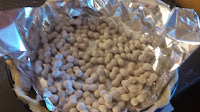 |
| The best raisin cream pie ever for my dad's 81st birthday |
While I appreciate their zeal for life, I also appreciate the gift that they give. They provide a wider variety of meats than any other animal, along with their hides and their marvelous fat. I've recently expanded into the world of lard making and enjoy it greatly. After spending my morning transforming two trash bags of fat into 36 pints of lard, my hands are positively luxurious. Lard has gotten a bad rap over the years, but it has a long history of many uses including soap and candles as well as making about the best biscuits you can get your hands on! It does not have the smokiness of bacon or really have any strong taste at all. It keeps fairly well and can be used to replace more processed oils and shortenings. Pie crusts, cookies, the list goes on and on. And we even cooked our pancakes in it last night to celebrate National Pancake Day.
There seem to be so many questions these days about where our food comes from and I've seen articles on Facebook touting various forms of oil as the best. Use olive oil, use canola oil, don't use vegetable oils, don't use canola oil, blah, blah, blah. I don't know what a canola is or how they get oil out of a vegetable. Everyone has an opinion and I'm always skeptical about those opinions because I feel like it's all based on whose footing the bill. What I can tell you about lard is that it has one ingredient - lard. Lard comes from melted pig fat. The fat is placed in a pot and melted until the fat portion becomes a liquid and separates from the meatier portion, which when cooked long enough becomes cracklings. The fat is then strained and cooled, forming a solid which can be used in place of solid shortening or melted again to be used as an oil. I'm not a dietitian, but from what I've read it is higher in Vitamin D, which is used to absorb calcium, than other fat sources and it is a source of healthy saturated fats which do have some health benefits. It's locally produced and just makes a nice quality food product.
 |
| The final product |
So with all that being said, not all lard is created equal. Make sure you purchase lard that requires refrigeration. The "shelf stable" lard from the grocery store has been stabilized somehow and is not in its purest state. Purchase lard from the refrigerator section of the grocery store or from your local butcher or farmer (hint, hint).
I'm including my new favorite pie crust recipe which uses just lard as shortening to produce a marvelously flaky crust. It makes enough dough for 3 crusts and can be frozen in dough rounds to use later. I was super impressed with this dough and how it held together. And believe me, I've tried a lot of pie crust recipes!
My Best Pie Crust
Sift 3 cups of flour and 1 teaspoon salt into a food processor. Add 1 cup lard and pulse until it's crumbly and there are no large pieces of lard remaining. In a cup or bowl, mix 1 well beaten egg with 3 tablespoons cold water and 1 tablespoon vinegar. Turn the processor onto a low speed and slowly add the liquid ingredients until the dough starts to come together. Turn it out on a lightly floured surface and work together into a soft dough. Divide the dough into 3 portions (about 9 ounces, if you're the precise weighing type!). Use the dough immediately or wrap in saran wrap and freeze for later use. Bring to room temperature before rolling out.
If you don't have a food processor, you can just cut the lard into the flour mixture and then stir in the wet ingredients with a fork just until combined.
 |
| The perfect pie crust before going in the oven |
I baked the crust at 425 for about 15-20 minutes, using my pie weights and foil for the first 10 minutes to use for a cream pie or whenever you need a pre-baked crust.


No comments:
Post a Comment